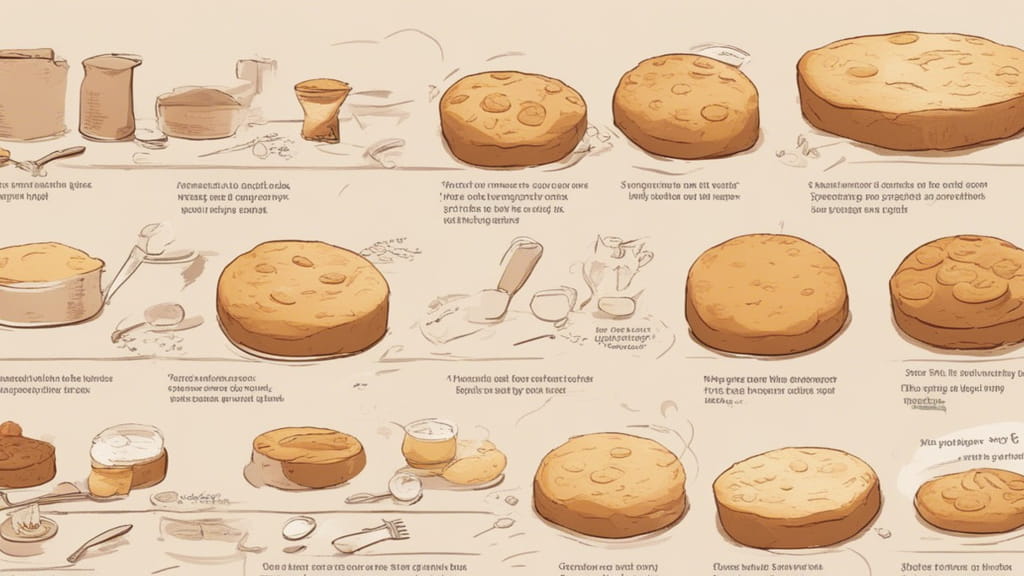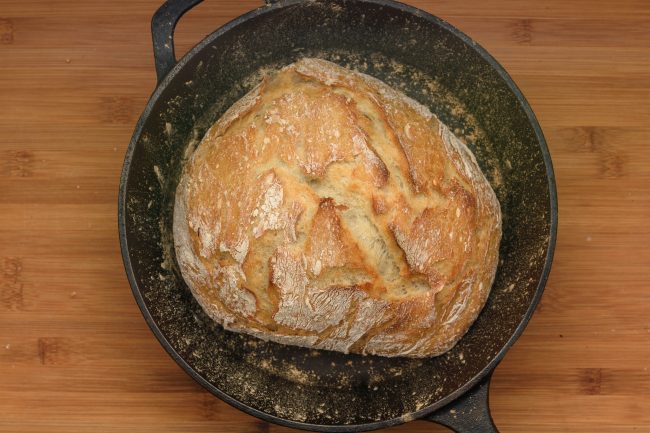Wondering what temperature is right for the dough to bake? Check out this guide, that makes sense into every cookie and cake!

Baking refers to foods lacking an initial structure, such as cakes, cupcakes, bread or cookies. On the other hand Roasting involves the cooking of foods such as meat, potatoes, chicken, and vegetables, which already possess a solid structure before cooking is initiated.
But why cookies are often baked at 350°F / 180°C, and vegetables are roasted at 425°F / 220°C? Or more importantly what’s the temperature when our baked goods are ready to be taken out of the oven?
Why Preheat the Oven?

Preheating involves setting an appliance to the desired temperature and allowing it to reach that temperature.
Not only ovens need preheating. Any appliance used for cooking food may also require preheating to ensure it attains the correct temperature. Some foods need to achieve crispiness or crunchiness, while others like cakes or breads need heat for the interaction with the leavening agents in the recipe to increase volume.
Food Safety and Preheating
Food safety serves as another important reason for the necessity of preheating in certain recipes and dishes. After all, the last thing anyone wants is to suffer from food poisoning, especially when serving family or guests. By preheating the oven beforehand, we ensure that the food reaches the desired temperature quickly, reducing the time it spends in the “danger zone,” where bacteria can rapidly multiply.
Therefore, when a recipe specifies preheating, it is imperative that the time is taken to carry out this step. It’s not a step that should be skipped.
When We Don’t Need to Preheat
However, not every instance of oven use necessitates preheating. For instance, when reheating or warming up a meal rather than cooking it from scratch, preheating is not mandatory.
According to the USDA, leftovers should be heated to 165°F / 73.9°C. Employing a food thermometer to verify the temperature, ensuring both safety and taste.
How Long Does It Take to Preheat an Oven?
Although newer ovens and smart ovens indicate when they’ve reached the desired temperature, this may not always be entirely precise. Keep in mind that the higher the temperature, the longer the preheating time. To err on the side of caution, especially when preparing meat and poultry dishes, it is advisable to wait approximately 20 minutes for the oven to preheat as thoroughly as possible.
Why is oven temperature important?
- 325-350°F / 163-177°C
This is a temperature range that is frequently utilized, and there is a reason for its popularity. Temperatures exceeding 300°F / 149°C are where caramelization (the browning of sugars) and the Maillard reaction (the browning of proteins) start to occur. This range is employed for dishes that require extended cooking times, such as slow roasts or braises. Cakes are also commonly baked at 350°F / 177°C due to their significant sugar content. If baked at a higher temperature, the cake’s exterior would burn before the center is fully cooked. - 375-400°F / 190-204°C
Slightly higher temperatures are favored for shorter-term baking or roasting to achieve crispy edges in cookies or bubbling golden cheese. This temperature range is also perfect for roasting chicken to achieve golden, crispy skin. As the temperature increases, so does the risk of burning, so vigilant monitoring of the oven’s contents is necessary. - 425-450°F / 218-232°C
This temperature is ideal for achieving perfectly golden roasted vegetables. It is recommended for short-term baking or roasting, providing a quick burst of high heat to achieve a golden color without an extended oven stay. For instance, when working with puff pastry, this temperature range is ideal as it ensures the oven temperature is over 400°F (204°C), allowing the release of steam that puffs up the pastry. - 475-500°F / 246-260°C
We are entering high-temperature territory. When cranking the oven up to its maximum setting, it is likely that pizza or bread is being prepared. The very high temperature causes the bread or pizza dough to rise and cook before the gluten has a chance to set, which is a desirable outcome.
How does it work

The importance of oven temperature lies in its ability to initiate and regulate various physical transitions and chemical reactions within the dough or batter. These processes play a crucial role in the sequential transformation of bread dough and other baked goods. Here, we explore these temperature-dependent stages, which contribute to the development of the final product:
Development (also known as oven spring)
As temperatures rise, the free water/alcohol mixture within the product undergoes vaporization. Fermentation gases (CO2) that are dissolved in the liquid dough phase become less soluble and are released into the cells, causing them to expand due to increased pressure. Consequently, cells expand in volume, creating an aerated structure within the dough. These changes are accompanied by various irreversible chemical and physical transformations.
- 122–140°F / 50–60°C
Yeast cells are killed. - 140°F / 60°C
Maximum enzymatic activity occurs promoting reactions that convert starch into sugars and break down proteins into amino acids, especially near the dough’s surface. - 130–150°F / 55–65°C
Starch gelatinization starts. - 122°F / 50°C
Gluten proteins denature. - 60–180°F / 70–80°C
Gluten proteins denature coagulate, resulting in gluten becoming progressively tough and stiff. - 60–185°F / 70–85°C
Naturally-occurring and added enzymes within the dough become inactive. - 185°F / 85°C and beyond
Starch takes on a glassy appearance, while gluten becomes rubbery, marking the start of the dough-crumb transition process (setting). Baking is practically finished.
Drying (reduction of dough/batter moisture)
- High temperatures within the baking chamber (390–570°F / 200–300°C) cause water molecules on the dough’s surface to absorb latent heat and evaporate.
- Due to the low humidity inside the baking chamber, a gradient in water vapor pressure (air moisture concentration) is established.
- Liquid-state water migrates from the product core to the surface, where it evaporates and is lost to the oven atmosphere.
- The rate of moisture loss depends on factors like baking chamber temperature, properties of free water in the product, heat transfer methods, and oven humidity.
Color Formation
The external surface of the product is directly exposed to the oven’s high temperatures, leading to the absorption of heat. These elevated temperatures initiate non-enzymatic reactions that result in the desirable brown crust.
- 220°F / 105°C
Maillard browning occurs and necessitates the presence of a reducing sugar (glucose, maltose, or lactose) along with an amino acid, determining both color and flavor - 320°F / 160°C
Sugar caramelization takes place, requires the presence of water.
Oven Temperature vs. Internal Product Temperature
- In most baking processes, dough pieces enter the oven at an initial temperature of 70–86°F / 20–30°C.
- The oven temperature remains relatively constant, typically set between 300–570°F / 150–300°C, and baking durations vary from 5–25 minutes.
- Since baking occurs at atmospheric pressure and moisture escapes freely without excessively drying the product, the internal temperature of the food typically does not exceed 212°F / 100°C (the boiling point of water).
- The core temperature of the product typically reaches 194-207°F / 90–97°C , with thicker bread requiring more time for heat to conduct to the center. This is the temperature that most of us know only as “golden brown” crust.
Monitoring the temperature profile of the oven through baking temperature/time profiling is essential to identify variations and address potential issues. Variations in oven temperature can lead to uneven coloring and moisture distribution in products, often caused by unbalanced heat transfer due to the placement of energy sources on conveying bands or decks. Properly addressing these variations ensures consistent and high-quality baked goods.
| Fahrenheit | Celsius | Gas Number |
| 225°F | 110°C | 1/4 |
| 250°F | 130°C | 1/2 |
| 275°F | 140°C | 1 |
| 300°F | 150°C | 2 |
| 325°F | 165°C | 3 |
| 350°F | 180°C | 4 |
| 375°F | 190°C | 5 |
| 400°F | 200°C | 6 |
| 425°F | 220°C | 7 |
| 450°F | 230°C | 8 |
| 475°F | 245°C | 9 |
| 500°F | 260°C | 10 |
| 550°F | 290°C | 10 |
Steam

Baking with steam is crucial for achieving optimal ovenspring. In a Dutch oven, the hydration of our loaf creates its own steam chamber. In an open bake, the addition of steam is necessary. The loaf’s surface needs to remain pliable and be in the presence of steam for about the first 20 minutes to inhibit the browning of the crust before the loaf has fully sprung.
The timing of when the lid of the Dutch oven is removed can impact ovenspring. The removal of the Dutch oven lid too early can result in the release of steam, which can hinder ovenspring. There is very little downside to keeping the lid on the Dutch oven longer to ensure that our loaf fully springs.
Summary
- Preheating the oven is necessary for food safety and optimizing baking times.
- Different chemical reactions happen at various temperatures. A kitchen thermometer is a valued investment.
- 185°F / 85°C is the temperature where gluten formation stops hence the baking process is finished.
- Steam inhibits the setting of the crust allowing the raise of the dough known as oven sprung.
